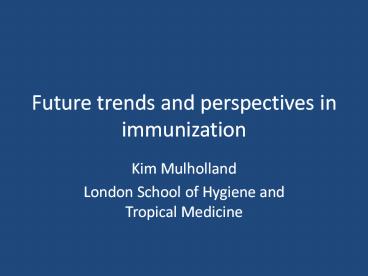Future trends and perspectives in immunization - PowerPoint PPT Presentation
Title:
Future trends and perspectives in immunization
Description:
Future trends and perspectives in immunization Kim Mulholland London School of Hygiene and Tropical Medicine Improving future goal setting: analysis and critique of ... – PowerPoint PPT presentation
Number of Views:217
Avg rating:3.0/5.0
Title: Future trends and perspectives in immunization
1
Future trends and perspectives in immunization
- Kim Mulholland
- London School of Hygiene and Tropical Medicine
2
Improving future goal setting analysis and
critique of the Millennium Development Goals
Waage J, Banerji R, Campbell O, Chirwa E,
Collender G, Dieltiens V, Dorward A,
Godfrey-Faussett P, Hanvoravongchai P, Kingdon
G, Little A, Mills A, Mulholland K, Mwinga A,
North A, Patcharanarumol W, Poulton C,
Tangcharoensathien V, Unterhalter E. The
Millennium Development Goals a cross-sectoral
analysis and principles for goal setting after
2015 Lancet and London International Development
Centre Commission. Lancet 2010 376 9911023.
3
1. Halve poverty and hunger2. Achieve
universal primary education3. Eliminate gender
disparity4. Reduce by 2/3 the child (lt 5)
mortality rate5. Reduce by 3/4 the maternal
mortality rate6. Halt and reverse the spread of
HIV AIDS and incidence of malaria and other
diseases7. Ensure environmental
sustainability8. Develop a global partnership
for development
The Millennium Development Goals
4
MDGs
- The positive side
- provided a focus for advocacy to improve
targeting and flow of aid - The problems.
- confusion between targets, indicators and goals
- ownership issues
- tendency to increase inequity
5
Future development goal setting five principles
- Holism consider all elements of well-being
- Ownership from national to global consensus
- Equity a pro-poor, rights-based approach
- Sustainability beyond economic growth
- Global obligation goals for all, not just the
poor
Lancet 2010 376 9911023.
6
Immunization part of the problem?
- The model vertical program
- Successful EPI programmes have established
parallel infrastructure in many countries,
bypassing inadequate health services - Campaigns approach
- Disrupts and undermines health services
- Even damages struggling EPI programmes
7
Immunization and equity
- Traditionally immunization is seen as pro-poor (
pro-equity) - Coverage beyond the reach of the routine health
services - Campaigns may reach 100 of the population
- Herd immunity provides protection for
unvaccinated children - Reaching Every District (RED) approach
- a sub-national approach to immunization data
collection
8
New vaccines promote inequity
- Between countries
- New vaccine use has been restricted to lowest
risk children in low risk countries - Within countries
- Promotion of lifesaving vaccines in private
sector of high mortality countries - Routine immunization excludes children not
reached by the health services (highest risk)
9
Immunization and equity impact of the MDGs
- Vaccination interventions low hanging fruit
- New vaccines presented with substantial (largely
unproven) promise - Pneumococcus (800,000 1 million deaths/yr)
- Rotavirus (500,000 deaths/yr)
- But
- Death from diarrhoea or pneumonia death from
lack of basic health care
10
The fundamental problem with modern immunization
data
- Most data are national averages
- Lives saved coverage X effectiveness
- Inaccurate
- Fundamentally misleading
- Children who die from diarrhoea or pneumonia are
usually marginalized, outside the health system - More honest would be
- Coverage amongst the highest risk group X
effectiveness
11
Post 2015
- The world can/will strive for greater fairness in
health - equity must be front and centre
- Pure survival is not enough, preventative
strategies must be paramount - Nutrition maternal and infant
- Healthy environment
- Immunization
- Prevention of specific diseases AIDS, malaria
- Health care must be comprehensive and integrated
- ( non-vertical)
12
Immunization and equity Trickle down or
Affirmative action?
- 100 coverage with all suitable vaccines
perfectly equitable - In the real world 1 or 50 unimmunized, these
will be the highest risk children - As coverage approaches 100
- Excluded are an increasingly small group of
increasingly high risk children
13
Use of immunization to promote equity
- Identify highest risk children and ensure that
coverage is highest among these groups - Selective use of vaccines against treatable
diseases (eg. Shigella) - Alternative strategies
- eg. maternal immunization to prevent early infant
illnesses and/or maternal infections - Who are the highest risk communities?
14
Who are the highest risk communities?
- Economically deprived
- Geographically isolated
- Ethnographically excluded
15
Who are the highest risk communities?
- Economically deprived
- Geographically isolated
- Ethnographically excluded
- Transient communities
- Internally displaced communities
- Refugees
- Victims of wars and natural disasters
- Even when we can do nothing else, we can provide
these communities with life-saving vaccines
16
Priorities for 2025
- Immunization must be at the vanguard of global
efforts to achieve fairer, more equitable health
outcomes - Strategies and new vaccines must focus on
- The needs of the highest risk communities (not
always in the poorest countries) - Ensuring that vaccination continues to be a major
force to promote equity in health outcomes






























